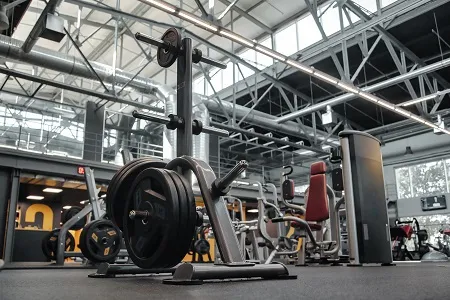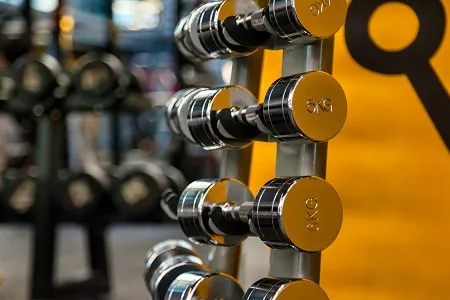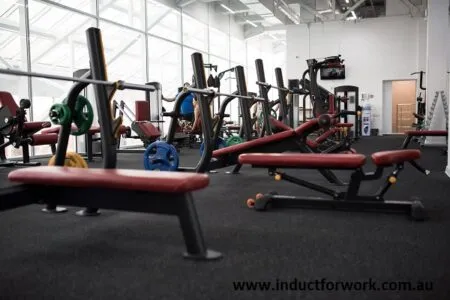Gym Safety Training
Running a fitness centre is more than keeping treadmills humming and membership numbers rising. A gym is a complex environment where heavy equipment, intense physical activity and close personal interaction merge each day. Clear, well-documented standard operating procedures (SOPs) protect members, safeguard staff and maintain the brand’s reputation. Yet creating, updating and enforcing these guidelines can overwhelm managers already juggling sales targets, class schedules and equipment servicing. This article explores the core components of a gym SOP, explains why consistent implementation matters and shows how Induct For Work’s learning-management platform transforms paper manuals into a living, trackable system.
Why SOPs are essential in fitness facilities
SOPs codify “the way we do things here,” reducing guesswork and aligning every team member with the same expectations. In the gym context, they:
- Protect health and safety – Proper barbell handling, spotting technique, chemical storage for pool areas and emergency response plans minimise accidents and liability.
- Deliver consistent member experience – From front-desk greetings to cleanliness checks, repeatable steps create predictable quality that keeps clients returning.
- Streamline training – New hires learn faster when tasks are broken into step-by-step routines rather than tribal knowledge.
- Support legal compliance – Work health and safety legislation, food regulations (for smoothie bars), privacy rules and COVID-era sanitation orders all demand documented proof of adherence.
- Improve efficiency – When everyone follows the same cleaning rota or equipment-maintenance schedule, downtime drops and asset life extends.
Without SOPs, gyms rely on individual judgment. Inconsistent cleaning, ad-hoc machine inspections and unclear evacuation procedures soon erode member trust and invite regulatory scrutiny.
Core sections of a gym SOP
While the exact order varies by business model—24-hour franchises, boutique studios or large aquatic centres—most fitness facilities should cover the following areas.
1. Member onboarding and check-in
Detail ID requirements, waiver collection, informed-consent forms and health questionnaires. Include scripts for reception staff and rules for minors, guests and short-term passes. Outline data-privacy practices for handling client information.
2. Facility access control
Define who opens and closes, how alarm systems are armed, and which staff can grant after-hours entry. For 24-hour operations, specify CCTV monitoring, panic-button testing and protocols if lone workers feel unsafe.
3. Equipment set-up, usage and maintenance
List pre-shift inspections: cable integrity on selectorised machines, belt alignment on treadmills, hydraulic settings on rowers. Stipulate daily, weekly and quarterly servicing schedules. Provide user instructions with visuals, correct weight-lifting techniques, required PPE for maintenance and lock-out tag-out steps when gear is out of order.
4. Cleaning and hygiene
Describe cleaning chemicals, dilution ratios, colour-coded cloths, personal protective equipment and touch-point focus zones. Include checklists for locker rooms, sauna areas and group-fitness studios. Document post-class wipe-downs and laundry procedures for towels and mats.
5. Group-class operations
Cover maximum participants, instructor qualifications, sound-level limits, lighting settings and floor-space layouts. Include pre-class screening for injury or medical conditions and safety briefings for high-intensity sessions or use of apparatus such as aerial silks or reformer beds.
6. Emergency response
Outline evacuation routes, fire-extinguisher locations, assembly points and roles—who contacts emergency services, who manages roll calls, who administers first aid. Store MSDS sheets near chemical areas. Incorporate incident-report forms and near-miss logs.
7. Staff conduct and communication
Define uniform standards, social-media guidelines, interactions with members, conflict-resolution steps and restrictions on personal training or product sales outside agreed terms.
8. Special services
If the gym offers childcare, physiotherapy or café services, include tailored SOPs for these zones—secure child-pickup protocols, patient-data handling or food-allergen controls.
Challenges in creating and enforcing SOPs

Many gyms start with good intentions: a thick binder labelled “Policies and Procedures” sits behind reception. Months later pages go missing, updated health regulations render sections obsolete and new employees skim rather than study them. Manual sign-off sheets pile up in drawers, offering little real-time visibility. Auditors find gaps, insurance premiums spike and, worst-case, incidents occur because someone never saw the latest revision.
Language barriers also grow as gyms hire international staff. Nuances of a safe-lifting cue can be lost if English translations are poor. Traditional induction sessions struggle to accommodate different shifts and part-time workers who can’t attend scheduled meetings. Keeping certificates—first aid, CPR, pool-lifeguard quals—up to date across rotating teams multiplies administration.
How Induct For Work revolutionises gym SOP delivery
Induct For Work is a cloud LMS purpose-built to make inductions, SOPs and compliance requirements accessible, engaging and verifiable.
- Digital modules with multimedia – Managers upload SOPs as videos, slide decks or interactive micro-lessons. A new trainer can watch a machine-maintenance demo on their phone before starting a shift, ensuring consistent standards.
- Multilingual support – Content can be duplicated into multiple languages so staff grasp critical instructions. Voice-over, captions and visual cues reduce misunderstanding.
- Role-based assignment – Front-desk employees receive customer-service and cleaning modules; group-fitness instructors see microphone-etiquette and participant-screening lessons; maintenance techs complete electrical-safety courses. No one wades through irrelevant material.
- E-signatures and quizzes – Staff complete short assessments that validate understanding. Digital signatures are time-stamped and stored against individual profiles, providing audit-ready evidence.
- Automated alerts and renewal tracking – First-aid certificates expiring in 30 days trigger reminders to both employee and manager. The platform prevents a staff member from clocking in for a lifeguard shift if their resuscitation credential lapses.
- Mobile offline capability – Employees can download modules at home, complete them without connectivity and sync later, perfect for coaches commuting between clubs.
- Instant reporting – At any point, managers generate dashboards showing completion rates, outstanding tasks and upcoming expiring documents, easing insurer or regulator inspections.
- Easy updates – When health-department guidelines change, administrators swap in revised cleaning SOPs. Staff receive notifications and must re-complete affected lessons, ensuring everyone works from the newest standard.
Building a SOP-driven culture with Induct For Work
Technology alone does not guarantee compliance. Combine the platform with regular reinforcement on the floor.
Micro-briefings – Use dashboards to identify modules with lower scores and run five-minute refresher huddles.
Visual signage – Snap screenshots of critical steps from modules and post them near equipment for quick reference.
Reward programmes – Recognise teams with 100% completion or zero equipment faults logged after a maintenance refresher. Positive reinforcement fuels engagement.
Review cycles – Schedule quarterly SOP audits. Gather feedback from trainers and cleaners on what works in practice, then update modules swiftly on Induct For Work.
Return on investment

Clubs that digitise SOPs see measurable gains:
Fewer incidents – Clear instructions reduce injuries, lowering compensation claims and absenteeism.
Regulatory confidence – Health inspectors reviewing sanitisation records find time-stamped evidence, often shortening audits.
Improved member satisfaction – Consistent greetings, spotless facilities and reliable class standards uplift Net Promoter Scores and retention.
Higher staff retention – Structured onboarding and visible skills growth make employees feel valued, decreasing turnover costs.
Operational efficiency – Administrators spend less time chasing paperwork and more on member-driven projects.
Standard operating procedures are the backbone of a well-run gym, safeguarding people and assets while delivering a seamless member experience. Paper manuals and scattered briefings struggle to keep pace with the ever-changing fitness landscape. Induct For Work turns static documents into dynamic, trackable learning journeys. With multilingual modules, automated credential tracking and instant reporting, managers can be confident every coach, cleaner and contractor understands exactly how to keep the facility safe, clean and welcoming. By combining clear SOPs with the right digital platform, gyms ensure their teams lift safety and service standards as effectively as their members lift weights.
Do you have any questions or great tips to share?
Induct for Work – the only online induction system you would need to run online inductions.



